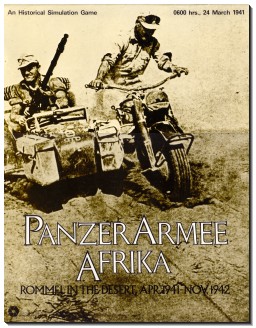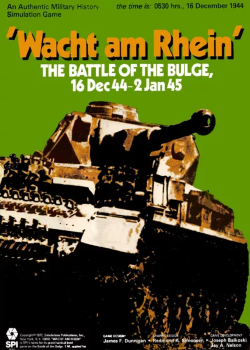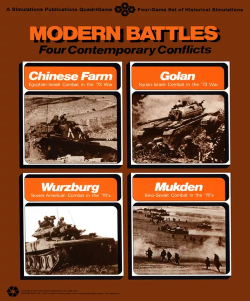
Burma is a board wargame published by Game Designer's Workshop (GDW) in 1976 that simulates the battle between Japan and an alliance of nations for control of Burma during World War II.

Burma is a board wargame published by Game Designer's Workshop (GDW) in 1976 that simulates the battle between Japan and an alliance of nations for control of Burma during World War II.
In December 1941, Japan invaded British-controlled Burma, opposed by a hastily arranged alliance of British, Indian and Chinese forces. By the end of 1942, Japan had taken control of Burma and threatened to invade India. [1]
Burma is a two-player wargame where one player controls the Japanese invaders who are trying to open a path to an invasion of India, and the other controls the Allied defenders trying to retake control of central Burma. [2] The game includes a hex grid map of Burma in 1942, 240 die-cut counters and an 8-page rulebook. [2]
The game uses an alternating turn sequence. First the Japanese player has the following phases:
Then the Allied player has these phases:
This completes one turn, which represents one month of game time. There are also rules for Long Range Penetration Forces using gliders, engineers building the Burma Road, and Chinese reinforcements. [3] There is only one scenario, which lasts 26 turns, covering the period following the establishment of Japanese rule in Burma in 1942 until the end of the war in 1945. [4] There are no optional rules.
Burma was designed by Marc Miller and was published by GDW in 1975 as a ziplock bag game. The rulebook served as the game cover, and featured artwork by Rodger B. MacGowan. [5] Critic Brian Train, writing in 1999, noted "The game attracted polite attention when it came out and has always been sought after by collectors and people interested in the subject." [4]
In his 1977 book The Comprehensive Guide to Board Wargaming , Nick Palmer commented on the "Suitably jungley-looking map with lots of difficult terrain, which helps the thin Allied defences to stop a Japanese breakthrough." Palmer noted the lack of complete elimination via combat and instead called Burma "a game of manoeuvre." [3]
In the November 1977 issue of Fire & Movement , Raymond Lowe was displeased by the way the rules were written, calling them "shoddy" and "too sketchy and full of loopholes." He concluded "there are those wargamers who like to play a game when they buy it without having to finish developing it first." [6]
In Issue 24 of the UK wargaming magazine Phoenix , J.B. Poole was initially pleased that the rulebook was only 8 pages, but then realized "one simply cannot cover such a complex matter so briefly [...] Regrettably [the rulebook] seems to need a great deal more developing." Poole concluded, "Can this game be recommended? I would say yes, with reservations. The overall conception is too good for the game to be rejected, but perhaps one should add the admonitory words: caveat emptor ." [2]
In The Guide to Simulations/Games for Education and Training, Martin Campion noted that "This game has both sketchy rules and overly intricate rules, but it is a valuable simulation of a very unusual campaign." [7]
In a retrospective review in Issue 5 of Simulacrum, Brian Train noted that "The game requires a fair amount of time to play, between five and ten hours, and play tends to proceed in fits and starts. This is quite realistic: there are five monsoon turns, some of them two months in length, that prevent movement or combat." Train also commented "The extremely rugged nature of the terrain and the tenuous supply situation result in a game of maneuver and logistics." [4]

PanzerArmee Afrika, subtitled "Rommel in the Desert, April 1941 - November 1942", is a board wargame published by Simulations Publications, Inc. (SPI) in 1973 that simulates the World War II North African Campaign that pitted the Axis forces commanded by Erwin Rommel against Allied forces. The game was revised and republished in 1984 by Avalon Hill.

Battle of the Bulge is a board wargame published by Avalon Hill (AH) in 1965 that simulates the World War II battle of the same name. General Anthony McAuliffe (ret.), who had been commanding officer at Bastogne during the Battle of the Bulge, was a consultant during the game's development. The game proved popular and sold more than 120,000 copies, but was dogged by criticisms of historical inaccuracies, and was finally replaced by a completely new edition in 1981. A third edition in 1991 was released as part of the Smithsonian American History Series.

Air Force is a board wargame published by Battleline Publications in 1976, and subsequently re-released by Avalon Hill in 1977, that simulates air combat during World War II. Several expansions for the game were also published.

Napoleon's Last Battles is a board wargame published by Simulations Publications in 1976 that simulates the last four battles fought by Napoleon. It was one of SPI's most popular games, and also received many positive reviews.

Wacht am Rhein is a grand tactical monster board wargame published by Simulations Publications, Inc. (SPI) in 1977 that simulates Germany's Battle of the Bulge offensive in late 1944 during World War II.

Narvik: The Campaign in Norway, 1940 is a board wargame published by Game Designers' Workshop (GDW) in 1974 that simulates Operation Weserübung, the German invasion of Denmark and Norway during World War II. The game was one of the first in the Europa series of twenty interlocking games envisioned by GDW that would cover the entire European and North African theatres from the start to the end of World War II, using identical map scales and similar rules.

The American Civil Revolution: 1775–1783 is a board wargame published by Simulations Publications Inc. (SPI) in 1972 that is a strategic simulation of the American Revolutionary War.

The American Civil War: 1861–1865 is a board wargame published by Simulations Publications Inc. (SPI) in 1974 that is a strategic simulation of the American Civil War.

The Marne: Home Before the Leaves Fall is a board wargame published by Simulations Publications Inc. (SPI) in 1972 that is a strategic simulation of the First Battle of the Marne during World War I. The subtitle is attributed to Wilhelm II, who supposedly told German soldiers in August 1914 "You will be home before the leaves fall from the trees."

Crimea: The Dawn of Modern Warfare is a board wargame published by Game Designers' Workshop (GDW) in 1975 that simulates the Crimean War.

Frederick the Great, subtitled "The Campaigns of The Soldier King 1756–1759", is a board wargame published by Simulations Publications Inc. (SPI) in 1975 that simulates several of the campaigns of Frederick the Great in Central Europe during the Seven Years' War. When SPI ran into financial difficulties, they sold the rights to the game to Avalon Hill, who produced a second edition in 1982.

Coral Sea, subtitled "Turning the Japanese Advance, 1942", is a board wargame published by Game Designers' Workshop (GDW) in 1974 that simulates the Battle of the Coral Sea in the Pacific Theater of World War II.

MechWar '77, subtitled "Tactical Armored Combat in the 1970s", is a board wargame published by Simulations Publications Inc. (SPI) in 1975 that simulates hypothetical tank combat in the mid-1970s between various adversaries, using the same rules system as the previously published Panzer '44.

Modern Battles: Four Contemporary Conflicts is a collection of four board wargames published by Simulations Publications Inc. (SPI) in 1975 that simulates four modern-day battles set in the early 1970s.

Battle for Midway: Decision in the Pacific, 1942 is a board wargame published by Game Designers' Workshop (GDW) in 1976 that simulates the Battle of Midway during World War II.
Tsushima is a board wargame published by Game Designers' Workshop (GDW) in 1975 that simulates naval battles during the Russo-Japanese War of 1904-1905. Tsushima was part of a two-game collection titled The Russo-Japanese War. The second game in the box was Port Arthur, which covered the land combat during the war. The two games could either be played separately, or combined into one master game.

Bar-Lev, subtitled "The Yom-Kippur War of 1973", is a board wargame published by Conflict Games in 1974, only months after the end of the Yom Kippur War. The game simulates battles on the two major fronts of the war: the Golan Heights and the Suez Canal. The game proved very popular, and a second edition was published by Game Designers' Workshop (GDW) in 1977.

Oil War: American Intervention in the Persian Gulf is a board wargame published by Simulations Publications, Inc. (SPI) in 1975 that simulates a hypothetical invasion of oil-producing countries in the Middle East in response to the oil crisis of 1973.
Port Arthur is a board wargame published by Game Designers' Workshop (GDW) in 1975 that simulates combat during the Russo-Japanese War of 1904-1905. Port Arthur was part of a two-game collection titled The Russo-Japanese War. The second game in the box was Tsushima, which covered the naval combat during the war. The two games could either be played separately, or combined into one master game.

Breakout & Pursuit: The Battle for France, 1944 is a board wargame published by Simulations Publications Inc. (SPI) in 1972 that simulates the breakout of Allied forces from Normandy during World War II, and their subsequent pursuit of retreating German forces.